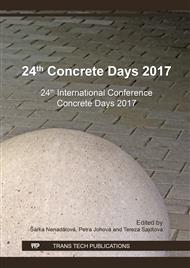p.273
p.280
p.284
p.290
p.299
p.305
p.313
p.319
p.325
Design of Concrete Pavement in the Považský Chlmec Tunnel
Abstract:
Construction of the Považský Chlmec Tunnel on the D3 Highway in the stretch Žilina (Strážov) – Žilina (Brodno) is being finished and the last structure before installation of the technological equipment has been a concrete pavement and construction works related to design and construction of the pavement. The paper describes not only the issue of road structural layers according to the regulation TP098 Design of Cement Concrete Pavements on Roads, but especially on a specific example of a tunnel already built we demonstrate general particularities of road surfaces in road and highway tunnels. These are, in particular, engineering requirements on the subgrade and possibilities of its drainage, design of joints of the cement concrete pavement in relation to the tunnel lining design, ensuring the necessary long-term roughness of the road surface, design of entries of utility lines (cables, drains) below the road surface, structural details connected with placement of kerbs and channel drains, lay-bys, impacts of use of self-extinguishing road drainage components in the load bearing system of the tunnel lining and other seemingly independent structures, which, however, in the confined tunnel space influence each other substantially. The paper focuses also on construction of the individual road courses with a recommendation for measures to adopt in order to eliminate damage to the tunnel structures completed (in particular, pavements, channel drains and kerbs), coordination of the other works in the tunnel ensuring safety of all workers, logistics (transport of pavers and cement concrete mix) and other apparently tiny details, which result in safe and fast work when placing the road courses in a restricted tunnel space. In the paper, the authors have taken into account requirements of the road engineering segment and also geotechnical requirements and particularities of the tunnel construction and point out the necessity of a multi-professional approach to the design to achieve an optimal solution. Based on their own experience, at the end of the paper, the authors give recommendations on amending the standards and regulations, which in some cases do not allow for construction of road surfaces in tunnels (i.e. deep under the ground).
Info:
Periodical:
Pages:
305-312
Citation:
Online since:
February 2018
Authors:
Price:
Сopyright:
© 2018 Trans Tech Publications Ltd. All Rights Reserved
Share:
Citation:


